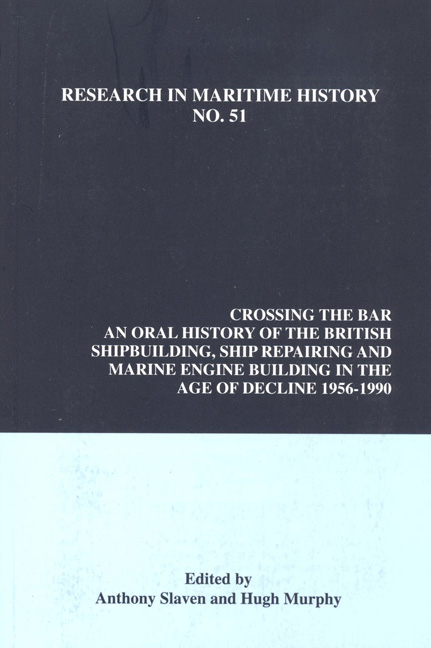 Crossing the Bar
Crossing the Bar Book contents
- Frontmatter
- Contents
- About the Authors
- Dedication
- Preface: A Shipbuilding Libretto
- Introduction
- Interviews
- Lower Clyde
- Upper Clyde
- 4 Sir Eric Yarrow, Weir Engineering, Cathcart, Yarrow Shipbuilders
- 5 Dr. Brian Baxter, Yarrow Shipbuilders
- 6 Bob Easton, Yarrow Shipbuilders
- 7 Sandy Stephen, Alexander Stephen Shipbuilders and Engineers
- 8 Professor John Rorke, Alexander Stephen, Denny Brothers, Brown Brothers
- 9 Fred Walker, Denny Brothers, Fairfield, Connell and Hall Russell
- 10 Jolyon Slogett, Denny Brothers, Houlder Bros., British Shipbuilders Plc
- 11 Dr. John Brown, John Brown, Clydebank
- 12 Graham Strachan, Alexander Stephen, John Brown and Scott Lithgow
- 13 J.F. Starks, John Brown, Upper Clyde Shipbuilders
- 14 Anthony Hepper, Upper Clyde Shipbuilders
- 15 Harry Osborne, Civil Engineer
- The Tyne
- The Wear
- Barrow-in-Furness
- The South Coast
- The Humber
- Belfast
- British Shipbuilding Industry Officials
- The Trade Unions
- The Civil Servants, Board of Trade, Shipbuilding Enquiry Committee, Shipbuilding Industry Board, Ministry of Technology, Department of Trade and Industry, Department of Industry
- The Politicians
- Interviews British Shipbuilders Plc
- Conclusion
- Select Bibliography
11 - Dr. John Brown, John Brown, Clydebank
from Upper Clyde
- Frontmatter
- Contents
- About the Authors
- Dedication
- Preface: A Shipbuilding Libretto
- Introduction
- Interviews
- Lower Clyde
- Upper Clyde
- 4 Sir Eric Yarrow, Weir Engineering, Cathcart, Yarrow Shipbuilders
- 5 Dr. Brian Baxter, Yarrow Shipbuilders
- 6 Bob Easton, Yarrow Shipbuilders
- 7 Sandy Stephen, Alexander Stephen Shipbuilders and Engineers
- 8 Professor John Rorke, Alexander Stephen, Denny Brothers, Brown Brothers
- 9 Fred Walker, Denny Brothers, Fairfield, Connell and Hall Russell
- 10 Jolyon Slogett, Denny Brothers, Houlder Bros., British Shipbuilders Plc
- 11 Dr. John Brown, John Brown, Clydebank
- 12 Graham Strachan, Alexander Stephen, John Brown and Scott Lithgow
- 13 J.F. Starks, John Brown, Upper Clyde Shipbuilders
- 14 Anthony Hepper, Upper Clyde Shipbuilders
- 15 Harry Osborne, Civil Engineer
- The Tyne
- The Wear
- Barrow-in-Furness
- The South Coast
- The Humber
- Belfast
- British Shipbuilding Industry Officials
- The Trade Unions
- The Civil Servants, Board of Trade, Shipbuilding Enquiry Committee, Shipbuilding Industry Board, Ministry of Technology, Department of Trade and Industry, Department of Industry
- The Politicians
- Interviews British Shipbuilders Plc
- Conclusion
- Select Bibliography
Summary
I started at Clydebank as an apprentice in the shipyard drawing office in 1919, and spent several years in the general drawing office. Having graduated from the University of Glasgow in 1923, I was then transferred to the ship design office as a naval architect, and continued there until 1927, when I was seconded to an associate firm in Spain under the direction of a former Clydebank man. I had two years in Spain as a designer, and as an estimator, coaching Spaniards. I returned to Clydebank where I was appointed Assistant Naval Architect. I served in that capacity from 1929 to 1949, which was a long haul. In 1949, I was made Naval Architect and Technical Manager in charge of the design and drawing office. From 1949 to 1959, I occupied that position, and then I was made Managing Director in succession to Sir James McNeil. I held that position until the end of 1963, when I handed over to John Rannie, with the idea that he would handle the construction of the Queen Elizabeth II. I had actually supervised the design in conjunction with Cunard, and supervised the tender which was eventually accepted. Since I was approaching retirement age, I was made vice Chairman, with a consultancy role, and stepped out altogether in 1967.
Our firm, I think, was in an individual position because of our size. We were, if not the biggest, one of the biggest in the industry, and in many ways that was strength. It meant that our main products were the very large ships, the passenger ships, and although we did compete in the market for smaller ships, our weakness might be that if there were any failure in the market for big ships we would be the sufferers. Another aspect in the situation of the firm; we were the main employer in the Clydebank community alongside the Singer Sewing Machine Company, and so there was a fair amount of folklore around the shipyards. The people of the district spoke of the yard as something that had always been there, and would always be there. There was a great deal of father and son associations. That particular aspect of things could well have been a weakness.
- Type
- Chapter
- Information
- Crossing the BarAn Oral History of the British Shipbuilding, Ship Repairing and Marine Engine-Building Industries in the Age of Decline, 1956-1990, pp. 43 - 46Publisher: Liverpool University PressPrint publication year: 2013
